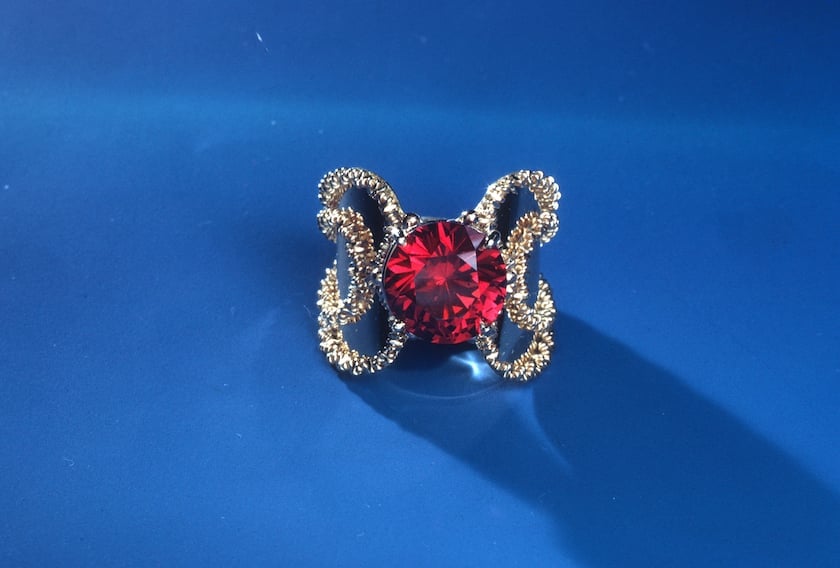How to Estimate Gem Weight in a Jewelry Setting
Although you can't weigh a gemstone in a jewelry setting, you can get a close approximation of the gem weight by determining its volume.
2 Minute Read
Step 1: Measure Your Gem
- Measure the gem carefully in every direction.
- Record all your measurements as well as the stone's shape. Take special note of its proportions.
- Finally, look up the specific gravity (SG) for the stone you're examining in our gem listings.
Step 2: Formulas for Estimating Faceted Gem Weight
Apply the proper formula for the gem based on its cut. The following formulas assume you're dealing with well-proportioned gems with a medium/thin girdle. If that's not the case, you'll have to adjust your results. See Step 4 below.
For all cuts except rounds and rectangular cushions, calculate the diameter as the average of the diagonal, length, and width.
Weight estimates are in carats.
Round
Diameter ✕ diameter ✕ depth ✕ SG ✕ 0.0018
Oval
Diameter ✕ diameter ✕ depth ✕ SG ✕ 0.0020
Square
Diameter ✕ diameter ✕ depth ✕ SG ✕ 0.0024
Square Cushion
Diameter ✕ diameter ✕ depth ✕ SG ✕ 0.0018
Square Step Cut
Diameter ✕ diameter ✕ depth ✕ SG ✕ 0.0023
Square with Cut Corners
Diameter ✕ diameter ✕ depth ✕ SG ✕ 0.0024
Rectangle
Length ✕ width ✕ depth ✕ SG ✕ 0.0026
Rectangle Step Cut
Length ✕ width ✕ depth ✕ SG ✕ 0.0025
Rectangle with Cut Corners
Length ✕ width ✕ depth ✕ SG ✕ 0.0026
Rectangular Cushion
Diameter ✕ diameter ✕ depth ✕ SG ✕ 0.0022 (NOTE: diameter = average of length and width)
Pear
Length ✕ width ✕ depth ✕ SG ✕ 0.0018
Heart
Length ✕ width ✕ depth ✕ SG ✕ 0.0021
Marquise
Length ✕ width ✕ depth ✕ SG ✕ 0.0017
Triangle
Length ✕ width ✕ depth ✕ SG ✕ 0.0018
Step 3: Formulas for Estimating Cabochon Gem Weight
Flat-bottomed cabs actually range from 0.0023 to 0.0029. Those with a bottom bulge range from 0.0024 to 0.0030. As a general rule, use the following formulas:
High-Domed Cabs
Length ✕ width ✕ depth ✕ SG ✕ 0.0026
Low-Domed Cabs
Length ✕ width ✕ depth ✕ SG ✕ 0.0029
Step 4: Adjusting Your Gem Weight Estimate
If the stone you're examining isn't well-proportioned or has a very thin or thick girdle, adjust your gem weight estimate as follows:
Girdle
Use an average of the girdle thickness. Don't base your reading on a bulge at the top of a heart or the point of a gem.
- Thin girdle, subtract 1% to 2%.
- Slightly thick, add 1% to 2%.
- Thick, add 3% to 4%.
- Very thick, add 5% to 6%.
- Extra thick, add 7% to 10%.
Pavilion Bulge
- Slight, add 3% to 5%.
- Noticeable, add 6% to 8%.
- Obvious, add 9% to 12%.
- Extreme, add 13% to 18%.
A long culet due to steep pavilion angles can add up to 5%.
Shape Outline
- Wide corners on cut corner squares and rectangles can decrease weight as much as 5%.
- For oval, pear, marquise, and heart cuts, wide wings or high shoulders can add up to 10%. Occasionally, straight shoulders will require a deduction of 1% to 5%.
- Marquise and (sometimes) pears will have a very short keel or none at all. This will reduce the weight by 1% to 3%.
- Triangles with straight sides will require a reduction of up to 10%.
International Gem Society
Related Articles
The Mohs Hardness Scale and Chart for Select Gems
METAL/WAX FORMULAS
Specific Gravity Values of Selected Gems
Birthstone Chart
Latest Articles
800 Years of Mogok: A Celebration in Tenuous Times
What is the Average Gemstone Faceting Yield?
Pyroxmangite Value, Price, and Jewelry Information
How to Identify Emerald Simulants and Synthetics
Never Stop Learning
When you join the IGS community, you get trusted diamond & gemstone information when you need it.
Get Gemology Insights
Get started with the International Gem Society’s free guide to gemstone identification. Join our weekly newsletter & get a free copy of the Gem ID Checklist!
